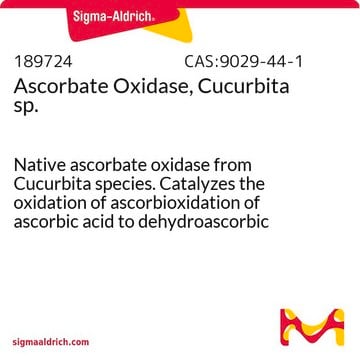This product has not been tested for solubility. However, external sources state that dehydroascorbic acid is soluble in DMSO at 10 mg/ml, and water at 50 mg/mL. This information has not been validated.
261556
(L)-Dehydroascorbic acid
Sinonimo/i:
DHAA, Dehydro-L-ascorbate, Dehydro-L-ascorbic acid, L-threo-Dehydroascorbic acid, oxidized ascorbic acid, oxidized vitamin C
Scegli un formato
Scegli un formato
About This Item
Prodotti consigliati
Forma fisica
powder
Livello qualitativo
Punto di fusione
228 °C (dec.) (lit.)
Temperatura di conservazione
−20°C
Stringa SMILE
OC[C@H](O)[C@H]1OC(=O)C(=O)C1=O
InChI
1S/C6H6O6/c7-1-2(8)5-3(9)4(10)6(11)12-5/h2,5,7-8H,1H2/t2-,5+/m0/s1
SBJKKFFYIZUCET-JLAZNSOCSA-N
Cerchi prodotti simili? Visita Guida al confronto tra prodotti
Descrizione generale
DHA is a dimer when it is solid, but when it is dissolved in a solution, it becomes a monomer.
Codice della classe di stoccaggio
11 - Combustible Solids
Classe di pericolosità dell'acqua (WGK)
WGK 3
Punto d’infiammabilità (°F)
Not applicable
Punto d’infiammabilità (°C)
Not applicable
Dispositivi di protezione individuale
dust mask type N95 (US), Eyeshields, Gloves
Scegli una delle versioni più recenti:
Possiedi già questo prodotto?
I documenti relativi ai prodotti acquistati recentemente sono disponibili nell’Archivio dei documenti.
I clienti hanno visto anche
Articoli
Simultaneous analysis of ascorbic acid and dehydroascorbic acid in various food samples by High Performance Thin Layer Chromatography (HPTLC).
-
What is the solubility of dehydroascorbic acid
1 answer-
Helpful?
-
Active Filters
Il team dei nostri ricercatori vanta grande esperienza in tutte le aree della ricerca quali Life Science, scienza dei materiali, sintesi chimica, cromatografia, discipline analitiche, ecc..
Contatta l'Assistenza Tecnica.









